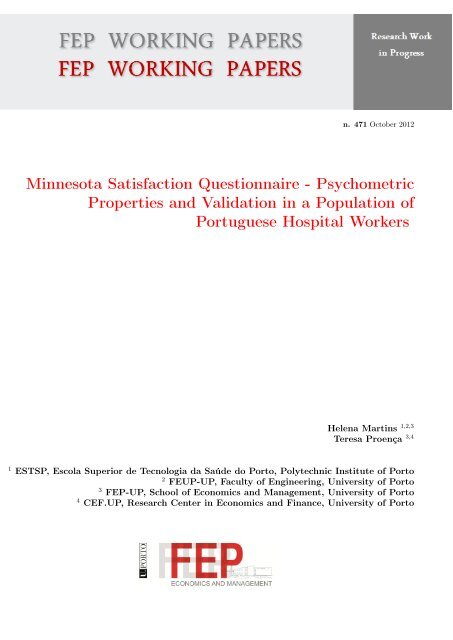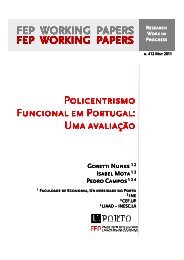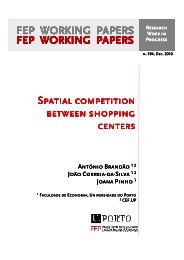Minnesota Satisfaction Questionnaire - FEP - Working Papers
Minnesota Satisfaction Questionnaire - FEP - Working Papers
Minnesota Satisfaction Questionnaire - FEP - Working Papers
Create successful ePaper yourself
Turn your PDF publications into a flip-book with our unique Google optimized e-Paper software.
n. 471 October 2012<strong>Minnesota</strong> <strong>Satisfaction</strong> <strong>Questionnaire</strong> - PsychometricProperties and Validation in a Population ofPortuguese Hospital WorkersHelena Martins 1,2,3Teresa Proença 3,41 ESTSP, Escola Superior de Tecnologia da Saúde do Porto, Polytechnic Institute of Porto2 FEUP-UP, Faculty of Engineering, University of Porto3 <strong>FEP</strong>-UP, School of Economics and Management, University of Porto4 CEF.UP, Research Center in Economics and Finance, University of Porto
MINNESOTA SATISFACTION QUESTIONNAIRE – PSYCHOMETRICPROPERTIES AND VALIDATION IN A POPULATION OF PORTUGUESEHOSPITAL WORKERSHelena MartinsEscola Superior de Tecnologia da Saúde do Porto, Instituto Politécnico do Porto (ESTSP), PolytechnicInstitute of PortoFaculdade de Engenharia da Universidade do Porto (FEUP), University of PortoFaculdade de Economia do Porto (<strong>FEP</strong>), University of Portohelenamartins@eu.ipp.ptTeresa ProençaCEF.UP, Faculdade de Economia do Porto (<strong>FEP</strong>), University of Portotproenca@fep.up.ptAbstractJob <strong>Satisfaction</strong> is usually treated as a collection of feelings or affective responsesassociated with the job situation, or “simply how people feel about different aspects oftheir jobs” (Spector, 1997: 2).In 1967, Weiss et al. developed the short version of the MSQ - <strong>Minnesota</strong> <strong>Satisfaction</strong><strong>Questionnaire</strong>, a 5-point Likert-type scale with 20 items. This scale has been widelyused in the literature being a well-known and stable over the time instrument withprevious researches yielding excellent coefficient alpha.In this study we developed an exploratory factor analysis to assess the factor structure ofthis scale in a Hospital Workers sample, with N=140, recurring to IBM – PASW andencountered a 2-factor structure. Following this procedure, we conducted aConfirmatory Factor Analysis using AMOS, where our exploratory structure wascompared with other structures found in previous studies.This work aims at improving our understanding of the nature and assessment of Job<strong>Satisfaction</strong> in the Portuguese healthcare context, providing a more stable ground forfuture research in this area.Keywords: Job <strong>Satisfaction</strong>, Confirmatory Factor Analysis, Healthcare contextJEL - Code: J281
1. INTRODUCTIONThis paper describes a study to further develop and test the psychometric properties ofthe <strong>Minnesota</strong> <strong>Satisfaction</strong> <strong>Questionnaire</strong> – Short Version (Weiss et al., 1967) includingreliability, in a Hospital Workers Population,.Numerous scales have been developed to measure Job <strong>Satisfaction</strong>. We chose to studythis particular scale since it presents several advantages: it is a well-known and stableover the time instrument; previous researches yielded excellent coefficient alpha values(ranging from .85 to .91); with 20 items, it is a parsimonious scale (in comparison withthe 72 items of the Job Descriptive Index, for example). Moreover, the MSQ has beenwidely studied and validated (Fields, 2002).For this study, a convenience sample of 140 hospital workers completed the MSQ-ShortVersion. Exploratory and Confirmatory Factor analysis were used for the evaluation andrefinement of the theory-based assignment of items to constructs. Reliability wasassessed using Cronbach’s internal consistency coefficient. The data were collected inMay/June of 2011.1.1 Job <strong>Satisfaction</strong>Job satisfaction can be defined as positive affect towards employment (Mueller andMcCloskey, 1990) and it is arguably a fairly stable evaluation of how the job meets theemployee’s needs, wants, or expectations (Fisher, 2003). In research, job satisfactionhas been assessed using global aspects as well as multiple facets like salary, careerprogression, supervisor, etc. (Fisher, 2003).Job <strong>Satisfaction</strong> has been playing a protagonist role in management research, namelyregarding the job satisfaction-job performance relationship (Petty et al., 1984; Fisher,2003). The search for a relationship between job satisfaction and job performance hasbeen referred to as the ‘Holy Grail’ of organizational behavior research (Weiss andCopranzano, 1996).This notion that satisfied employees will perform their work more effectively is thebasis of many theories of performance, reward, job design and leadership (Shipton etal., 2006). Managers and lay people are thought to believe in what has been called the‘happy–productive worker hypothesis’ (Fisher, 2003).2
Regardless of the success (or lack thereof) scholars might have had in proving theconnection between Job <strong>Satisfaction</strong> and Performance, the latter remains one of themost prominent variables in study in business science and organizational behavior(Spagnoli et al., 2012). This subject seems to be relevant for scholars, managers andemployees alike. It is relevant for scholars interested in the subjective evaluation ofwork conditions; for managers and researchers regarding organizational outcomes (e.g.organizational commitment, extra-role behavior); for employees, job satisfaction hasimplications for subjective well-being (Judge and Hulin, 1993) and life satisfaction(Judge and Watanabe, 1993), and it is assumed to have major implications as it is aprevailing construct covering all professions, work, jobs and contexts (Spagnoli et al.,2012).Job satisfaction is an attitude that relates to overall attitudes towards life, or lifesatisfaction (Illies et al., 2009) as well as to service quality (Schneider and Bowen,1985).1.2 JS in the Healthcare ContextIn the healthcare context, studies have emerged demonstrating the relationship betweenjob satisfaction and quality of care. Evidence suggests that nurses’ job satisfactionaffects patient satisfaction and the quality of patient care (Aiken et al., 1994; Aiken etal., 1997); that good human resources management make a difference in the hospitalsetting (Buchan, 2004) and even reduce mortality (West et al., 2006). The positivecorrelation between nurses’ job satisfaction and retention is well established (Leveckand Jones, 1996; Molassiotis and Haberman, 1996).Job satisfaction research in healthcare has been conducted mainly accordingly todifferent professions, studying nurses, doctors, therapists, etc. separately. Thereforethere seems to lack a global approach to healthcare, namely at hospitals, envisaging allemployees as an important part of the healthcare service. Bearing in mind thatHealthcare is a service industry where the overall service experience is important forcustomer satisfaction and quality of care (even if in different extents according to theprofessional at stake) and that the literature has been bringing about the pertinence ofsuch a holistic approach (e.g. Veld et al., 2010), this research was conducted within thisperspective.3
1.3 <strong>Minnesota</strong> <strong>Satisfaction</strong> <strong>Questionnaire</strong>Several approaches have been considered assessing and evaluating job satisfaction inboth theoretical and practical researches.Operationally, one of the greatest difficulties in assessing job satisfaction is that it ispossible to be satisfied with some aspects of a job and at the same time be dissatisfiedwith others (Spagnoli et al., 2012).The literature endorses two main approaches to measuring job satisfaction: an overallmeasure of job satisfaction or one regarding several aspects of job satisfaction.The first approach takes a macro perspective and consists in asking the respondentdirectly about his or her overall feelings about the job, being frequently build up withonly one item (Wanous et al., 1997); the second approach emphasizes different aspectsof the job. It is the extent to which an individual is satisfied with the several facets ofthe job that determines the overall degree of job satisfaction, frequently adopting afacet-sum approach. Some of the most popular measures in the field, e.g. the JobDescriptive Index (Smith et al., 1969), the <strong>Minnesota</strong> <strong>Satisfaction</strong> <strong>Questionnaire</strong> (Weisset al., 1967), the Job <strong>Satisfaction</strong> Survey (Spector, 1985) adopt this perspective.One presumable advantage of multidimensional measures of job satisfaction is thatcomponents may relate differently to other variables of interest contributing to a deeperunderstanding on the subject, advancing science and practice of industrialorganizationalpsychology (Hirschfeld, 2000).The <strong>Minnesota</strong> <strong>Satisfaction</strong> <strong>Questionnaire</strong> was one of the outputs from the “WorkAdjustment Project” at the University of <strong>Minnesota</strong>; the underlying theory is based onthe assumption that work fit is dependent on the correspondence between the individualskills and the reinforcements that exist in the work environment (Weiss et al., 1967).This is a self-reporting measure, suitable for individuals of all school levels that can beadministrated separately or individually.The 20 MSQ-short version items items are rated on a 5-point Likert scale (1 “verydissatisfied with this aspect of my job”, 2 “dissatisfied with this aspect of my job”, 3“can’t decide if I’m satisfied or dissatisfied with this aspect of my job”, 4 “satisfied withthis aspect of my job” and 5 “very satisfied with this aspect of my job”). Item responsesare summed or averaged to create a total score – the lower the score, the lower the levelof job satisfaction.4
The MSQ “long form” consists of 100 questions that make up 20 subscales assessingsatisfaction; twenty of these items make up a frequently used measure of general jobsatisfaction and are referred to as the short version of the MSQ (Fields, 2002).The MSQ “short form” includes only 20 of the 100 original items, namely, the ones thatbetter represented each of the 20 original subscales (Ahmadi and Alireza, 2007).Moorman (1993, cit. in Fields, 2002) factor analyzed the MSQ and found two factors:one assessing satisfaction with intrinsic aspects of the job and the other assessingsatisfaction with the extrinsic aspects. Schriesheim et al. (1993) found a structure of 3subscales: intrinsic, extrinsic and general satisfaction. In Mathieu (1991), an exploratoryfactor analysis of the MSQ yielded four factors. These four subscales includedsatisfaction with working conditions, leadership, responsibility and extrinsic rewards.Confirmatory factor analysis performed by Igalens and Roussel (1999, cit. in Fields,2002) showed that a four factor analysis fit the data best. The four factors were; intrinsicsatisfaction, extrinsic satisfaction, recognition and authority/social utility.2. METHOD2.1 SampleThe present study is based on a sample of 140 individuals, pertaining to a Hospital ofsmall dimension in Portugal. This Hospital is a public sector institution, with over 200years of existence, employing circa 200 workers in the center of Portugal.Ages of respondents vary between 22 and 74 years old (mode= 53 years andmean= 43.4 years; standard deviation= 10.5); most respondents are female (79.3%female respondents; 16.4% male respondents; 4.3% did not answer this question). Interms of the job, the distribution of staff per job group is shown in Figure 1, wherenursing staff represents 23% of the total staff, medical doctor take up about 11%,helpers, that is to say the operational assistants for nurses and doctors, are about 29%,other health related staff (such as physical therapists, speech therapists, psychologists,etc.) represent 17%, administrative/support staff (employees with clerical functions)take up 14% and finally 7% are support jobs, related to maintenance and other logistics.5
Admnistrativestaff14%Support Staff7%Nurses23%Other Healthrelated staff16%Helpers29%Doctors11%Figure 1. Percentages of staff in different job functions in our sampleIn terms of seniority, values range between less than a year to up to 43 years (mode=3years and mean= 16.2 years, standard deviation= 11.6), where a significant amount ofworkers (50%) have an effective contract (hired with no predetermined ending date ofthe bond with the organization). When it comes to schooling, 22% of subjects have aschool level inferior to the mandatory Portuguese level (9th year), 22.9% attended orgraduated from middle school, 42.9% attended or graduated from College and 9% havepost-graduate schooling (Specializations, Masters Degree, etc.).In the present sample, descriptive statistics for each item revealed that the answers toalmost all items ranged between the minimum and the maximum (Table I). Thefrequency’s analysis in each response option revealed an acceptable distribution in allthe items, with no percentages above 50% in a single response alternative. Thisindicates the existence of response variety and a reasonable discriminative power of theitems.In most items, means and medians are similar; skewness and kurtosis values areacceptable, indicating that its distribution approximates the normal distribution.6
Table I – Content, means and standard deviations of the itemsItemsMeanStandardDeviation1. Being able to keep busy all the time.4.04 0.782. The chance to work alone on the job.4.18 0.843. The chance to do different things from time to time.3.57 0.964. The chance to be “somebody” in the community.4.10 0.745. The way my boss handles his/her workers.3.75 1.006. The competence of my supervisor in makingdecisions.7. Being able to do things that don’t go against myconscience.3.78 0.903.99 0.828. The way my job provides for steady employment.3.52 1.069. The chance to do things for other people.4.25 0.7610. The chance to tell people what to do.3.59 0.8011. The chance to do something that makes use of myabilities.4.10 0.8012. The way company policies are put into practice.3.07 0.9013. My pay and the amount of work I do.2.61 1.1214. The chances for advancement on this job.3.00 1.1615. The freedom to use my own judgment.3.62 0.9016. The chance to try my own methods of doing thejob.3.69 0.8617. The working conditions.3.75 0.9518. The way my co-workers get along with each other.3.60 0.9519. The praise I get for doing a good job.3.66 1.0520. The feeling of accomplishment I get from the job.3.99 0.912.3 Data collectionData were collected by a researcher on the premises. <strong>Questionnaire</strong>s were given to allworkers listed in the hospital’s sheet that were in loco during June of 2011. When asubject couldn’t complete the questionnaire for the researcher to collect it promptly, asealed box was available at the head nurse’s office and at the hospital’s bar fordepositing answered surveys, thus conserving the confidentiality and anonymity of therespondents.7
2.4 Portuguese Version of the InstrumentThe translated version of Weiss and colleagues (1967) 20 item scale proposed byMartins (2008) was used. Martins (2008) started with the translation of the instrumentto Portuguese, followed by a backtranslation by an Englishman proficient in thePortuguese language, so to compare the original and the back translated items, thereforeensuring the reliability of the adaptation. After this process, a pilot study was conductedwith a small group of workers of an industrial company, where the talked reflectionaround the scale leads to small final adjustments in terms of language.2.5 Data analysisConstruct validity estimates the ability of an instrument to measure the underlyingconstruct of interest (Ellenbecker and Byleckie, 2005). Exploratory factor analysis(EFA) has traditionally been employed by researchers as a tool to determine the numberof underlying dimensions in a data set by grouping variables that are correlated(Tabachnick and Fidell, 2007).The technique of Confirmatory Factor Analysis analyzes a priori measurement modelsin which both the number of factors and their correspondence with the indicators areexplicitly specified (Kline, 2011).<strong>Questionnaire</strong>s were returned to the researchers and data were coded and entered intoPASW 18 for Windows; for CFA, AMOS 18 software was used.The degree and pattern of missing data were observed for each variable and case. It wasdetermined that data were missing randomly (Tabachnick and Fidell, 2007). Theamount of missing data on the MSQ items varied from 0,7% to 5,9%, with an average2,6% missing data per case. To prevent the potential of bias due to missing cases(Kneipp and McIntosh, 2001), missing data were replaced by imputed data using amean estimation procedure provided by the missing value analysis command (MVA) inPASW.3. RESULTS3.1 Exploratory Factor AnalysisA principal components analysis (PCA) was conducted on the 20 items with obliquerotation (oblimin) using PASW software. The Kaiser-Meyer-Olkin measure verified thesampling adequacy for the analysis, KMO=0.85 (“meritorious”, according to Sharma,8
1996) and all KMO for individual items (measures of sample adequacy) were >0.7,which is well above the acceptable limit of 0,5 (Field, 2009). Bartlett’s test of sphericity 2 (45)=685.67, p< 0.001, indicated that correlations between items were sufficientlylarge for PCA.Table II - Oblimin rotated component matrix based on correlations among the items ofthe MSQ and communalities (h 2 ).Component 1 Component 2 h 2MSQ 19 – The praise I get for doing a good job .81 .21 .71MSQ 3 – The chance to do different things from time to time .78 .14 .62MSQ 10 – The chance to tell people what to do .76 .23 .59MSQ 11 – The chance to do something that makes use of myabilities.75 .18 .64MSQ 16 – The chance to try my own methods of doing the job. .72 .16 .55MSQ 15 – The freedom to use my own judgment .70 .31 .59MSQ 5 – The way my boss handles his/her workers. .15 .86 .75MSQ 6 – The competence of my supervisor in making decisions .21 .81 .70MSQ 2 – The chance to work alone on the job .32 .66 .53MSQ 4 – The chance to be “somebody” in the community .14 .65 .44% of Variance accounted for 46,62% 14,56%Items 1, 3, 15, 17, 18 and 19 were eliminated from the analysis due to lowcommunalities and items 2, 9 and 14 were dropped due to multiple component loading.Two components had eigenvalues over Kaiser’s criterion of 1 and an analysis of thescree plot indicated the existence of two components as well. Table II shows the factorloadings after the rotation. The items that cluster on the same components suggest thatcomponent 1 represents satisfaction with task enrichment and component 2 satisfactionwith leadership and empowerment.Internal consistency was estimated using Cronbach’s alpha. The two factors that wefound showed a good internal consistency, with alpha values above 0.70 (Nunnally,1978): α =. 87 for factor 1 (satisfaction with task enrichment, 6 items), α =.78 for factor2 (satisfaction with leadership and empowerment, 4 items) and α =.87 for the globalscale.3.2 Confirmatory factor Analysis3.2.1 Previous Factor SolutionsAfter the original Weiss et al.’s (1967) factor solution, Schriesheim and colleagues(1993) conducted a content adequacy assessment of the MSQ short-form intrinsic andextrinsic subscales. These subscales were initially constructed through an empiricalapproach that relied on factor-analytic results (Weiss et al., 1967). On the basis of their9
content adequacy analysis, however, Schriesheim and colleagues (1993) concluded thatthe content adequacy of the original MSQ short-form subscales is questionable andproposed the factor structure displayed in Table III. Specifically, besides changing theallocation of some items form extrinsic to extrinsic and vice-versa, Schriesheim andcolleagues’s (1993) results indicated that two general satisfaction items (items assignedto neither the intrinsic nor the extrinsic subscale).These authors also recommended thatappropriate revisions be made to the subscales’ composition, placing some of the itemsdifferently from the original authors, attributing them to other subscales (cf. Table III).In the Portuguese context, Martins (2008) developed the adaptation and validation studyamong Portuguese Industrial Workers (N=135) that originated the Portuguese version ofthe MSQ and is used in this study. The author found a 2-factor structure , naming themextrinsic and intrinsic job satisfaction respectively, using a principal axis factoringextraction method with varimax rotation. This factor solution has 14 items; 6 items weredropped due to low communalities and multiple factor loadings as reported by theauthor (Martins, 2008). The scale and its factors presented high levels of reliability,with α values of 0.88 for the MSQ global scale, 0.87 for the internal satisfaction factorand 0.77 for the external satisfaction factor.Also in the Portuguese context, in 2011, Sousa and colleagues developed a researchwith Pharmacists and Pharmacy Workers, building on the same version of the adaptedscale by Martins (2008). Authors used a sample of N=291 and found a 2 factor structurefor the scale, using principal components analysis extraction and a varimax rotationnaming the components extrinsic and intrinsic job satisfaction, according to the contentof the items and following a tradition of research in this area (cf. Fields, 2002, for moredetails). A solution with 11 items emerged where 9 items were dropped due to lowcommunalities and multiple factor loadings as reported by the author (Sousa et al.,2011). In this research scale reliability estimated through Cronbach’s alpha presentedgood results: global scale α= 0.91; extrinsic satisfaction α= 0.88 and intrinsicsatisfaction α = 0.86.10
Table III – Summary of previous factor solutions found in the literature.OriginalSchriesheim Martins, Sousa etet al., 1993 2008 al., 2011Present Study1. Being able to keep busy all the time. Intrinsic Intrinsic Extrinsic * *2. The chance to work alone on the job. Intrinsic Intrinsic Intrinsic Intrinsic Supervisor/Empowerment3. The chance to do different things from time to time. Intrinsic Intrinsic * * Taskenrichment4. The chance to be “somebody” in the community. Intrinsic General Intrinsic Intrinsic Supervisor/Empowerment5. The way my boss handles his/her workers. Extrinsic Extrinsic Extrinsic Extrinsic Supervisor/Empowerment6. The competence of my supervisor in making decisions. Extrinsic Extrinsic Extrinsic Extrinsic Supervisor/Empowerment7. Being able to do things that don’t go against my conscience. Intrinsic Intrinsic * * *8. The way my job provides for steady employment. Intrinsic Extrinsic * * *9. The chance to do things for other people. Intrinsic Intrinsic Intrinsic Intrinsic *10. The chance to tell people what to do. Intrinsic Intrinsic Intrinsic * Taskenrichment11. The chance to do something that makes use of my abilities. Intrinsic Intrinsic Intrinsic Intrinsic Taskenrichment12. The way company policies are put into practice. Extrinsic Extrinsic Extrinsic Extrinsic *13. My pay and the amount of work I do. Extrinsic General Extrinsic Extrinsic *14. The chances for advancement on this job. Extrinsic General Extrinsic Extrinsic *15. The freedom to use my own judgment. Intrinsic Intrinsic Extrinsic * Taskenrichment16. The chance to try my own methods of doing the job. Intrinsic Intrinsic Intrinsic * Taskenrichment17. The working conditions. General Extrinsic Extrinsic Extrinsic *18. The way my co-workers get along with each other. General Extrinsic * * *19. The praise I get for doing a good job. Extrinsic General * * Taskenrichment20. The feeling of accomplishment I get from the job. Intrinsic Intrinsic * Intrinsic ** Items marked * were dropped in the analysis due to low communalities or multiple factor loadings.11
3.2.2 Comparison between the modelsThe two-dimensional model underlying this scale has gathered empirical support inseveral studies (cf. Fields, 2002), and is today a widely referenced and reputed model.However different structures have emerged in the studies developed by Sousa andcolleagues (2011), Martins (2008) and the present study where samples of PortugueseWorkers were used, suggesting that the original model might not be transversal toworkers of different cultures or different sectors, as other authors had already pointedout (Fields, 2002).Thus, a confirmatory factor analysis (CFA) was conducted with AMOS 18 software(Byrne, 2010) using Weighted Least Squares (WLS) estimation.The data exploring accounted for global criteria (allowing the analysis of thesustainability of the hypothesized model as a whole) and specific criteria (centered inthe analysis of the adequacy of individual parameters) (Ullman, 2007; Byrne, 2010;Kline, 2011). Concerning the first ones, there are several fit indices, turning toresearchers the task of choosing the ones to base the analysis upon. According to theabove mentioned authors, we used the Chi-Square test statistic, the CFI (ComparativeFit Index), the AGFI (Adjusted Goodness-of-Fit Index), and the RMSEA (Root MeanSquare Error of Approximation) as well as its respective confidence interval. The use ofthese statistics is well supported by the literature (Byrne, 2010) and therefore arefrequently referenced. For these indices and according to the generally recommendedand accepted values by the authors, the following criteria was used to assess the fitbetween the data and the hypothesized models: non significant 2 or the ratio betweenits value and the corresponding degrees of freedom near or less than 2, due to thereputed sensibility of the Chi-Square test (e.g. Ullman, 2007); CFI values near orgreater than .95 (Hu and Bentler, 1999); AGFI values near or greater than .90; andRMSEA values of less than .08 (Browne and Cudeck, 1993). Concerning the analysis ofthe individual parameters of the model, we considered the weight of its estimation andits statistical significance.The goodness of fit indices values obtained for the model that posits this study’sstructure revealed a better fit than the previous tested structures, showing satisfactoryvalues for all the estimated indices (Table IV).12
Table IVGoodness of fit indices obtained in the confirmatory factor analysis of the MSQ-Short formOriginal model20 itemsSchriesheim et al. (1993)20 itemsModel obtained by the present study10 itemsModel obtained by Martins (2008)14 itemsModel obtained by Sousa et al. (2011)11 items* p
in the CFI value larger than .01 (Cheung and Rensvold, 2002) for this model versus theother two models (Table IV).4. DISCUSSIONThe results of this study provide evidence that the MSQ-Short Version is a valid andreliable scale for the measurement of job satisfaction of hospital workers.Construct validity of the MSQ was explored by factor analysis, which determined theconvergent assignment of constructs to items within each subscale of the MSQ. Theitems show good communalities and strong factor loadings. The originally hypothesizedsubscales are different from the ones that emerged in this paper.The factor structure we encountered in the Exploratory Factor Analysis is veryinteresting, since it presents a fresh perspective of Job <strong>Satisfaction</strong>. We knew from thestart that this would be a hard task to handle since there is a lot of variety of staffincluded in the sample, with different views and job descriptions, from nurses tohelpers, to IT technicians, to doctors, etc. There seem to be few studies on Hospitals asa whole, so the development of a factor structure that allows us to grasp how theensemble of a Public Hospital in Portugal as a whole encompass job satisfaction, is ofinterest. That is to say, unlike previous studies where intrinsic and extrinsic jobsatisfaction emerged, for this population it seems to make more sense to speak of jobenrichment and supervisor/empowerment satisfaction.The absence of a dimension with extrinsic satisfaction (especially if we consider that inthe previous studies we found extrinsic satisfaction to be dominant in terms of explainedvariance) may be related to traditionally very strict and clear rules of payment andcareer development in the Portuguese Public sector, where seniority was traditionallyalmost the sole factor that influenced career advancement. If the advancement in careerand overall pay increase is not perceived as a result of one’s effort, work or performancein any way, it is plausible to suggest that subjects may consider extrinsic factors asseparate constructs from job satisfaction and possibly associate them with a differentconstruct. Additionally, career advancement and pay raises have been frozen for yearsin the Portuguese public sector, increasing the perceived gap between what the subjectdoes and what the subject gets in terms of extrinsic motivators.Instead, these workers as a whole make sense of mostly intrinsic satisfaction items,where there seems to be two major latent constructs: how interesting and useful the job14
is (“Task enrichment”) and how empowered and happy with their supervisor’scompetency the workers are (“satisfaction with empowerment and leadership”).5. CONCLUSIONFor research on job satisfaction to be useful, it is imperative that job satisfaction scalesare precise in measuring what they are designed to assess (Spector, 1997; Hirschfeld,2000) and the understanding of the nature and specificities of contextual job satisfactionis an important first step in defining adapted and efficient managerial policies (Ferreiraet al., 2009).Based on the psychometric testing presented here, the MSQ is a valid instrument formeasuring job satisfaction of global hospital workers.5.1 Limitations and future research directionsThis study presents some limitations, namely the fact that the data were collected fromthe same source, and that the sample is relatively small.Future research should focus on verifying the external validity of the factor structurefound in this study. It would be interesting to realize if this primal focus on intrinsicsatisfaction items in the Factor Analysis remains across the Healthcare sector, pointingout to a rather interesting characteristic of this population: the importance of being ableto do a good job (as shown by component 2 “satisfaction with empowerment andleadership”) as well as a strong commitment to their own personal and professionaldevelopment (as shown by component 1 “Task enrichment”).A larger data set will serve to confirm aspects of the current research, resolveinterpretative issues, and elucidate any additional structure of responses through theapplication of expanded statistical procedures. Research activities should explore thesubscale constructs, the stability of the constructs across the population of Hospitalworkers, and the MSQ as a total scale.6. REFERENCESAhmadi, Khodabakhsh, and Alireza, Kolivand (2007), "Stress and Job <strong>Satisfaction</strong>among Air Force Military Pilots", Journal of Social Sciences, 3: 159-63.15
Aiken, L.H., Lake, E.T. , Sochalski, J. and Sloane, D.M. (1997), "Design of anOutcomes Study of the Organization of Hospital Aids Care", Research in theSociology of Health Care, 14: 3-26.Aiken, L.H., Smith, H.L. and Lake, E.T. (1994), "Lower Medicare Mortality among aSet of Hospitals Known for Good Nursing Care", Medical Care 32(8): 771-87.Browne, M. W., and Cudeck, R. (1993), "Alternative Ways of Assessing Model Fit." InTesting Structural Equation Models, ed. K. A. Bollen and J. S. Long. NewburyPark, CA: Sage, pp. 136-62.Buchan, M. (2004), "What Difference Does ("Good") HRM Make?", Human Resourcesfor Health, 2(6).Byrne, Barbara M. (2010), Structural Equation Modeling with AMOS: Basic Concepts,Applications, and Programming, New York: Routledge.Cheung, G. W., and Rensvold, R. B. (2002), "Evaluating Goodness-of-Fit Indexes forTesting Measurement Invariance", Structural Equation Modeling, 9: 233-55.Ellenbecker, C. H., and Byleckie, J. J. (2005), "Home Healthcare Nurses’ Job<strong>Satisfaction</strong> Scale: Refinement and Psychometric Testing", Journal of AdvancedNursing, 52(1): 70–78.Ferreira, J. A., Fernandes, R., Haase, R. F. and Santos, E. R. (2009), "<strong>Minnesota</strong><strong>Satisfaction</strong> <strong>Questionnaire</strong> - Short Form: Estudo de Adaptação e Validação Paraa População Portuguesa", Psychologica, 51: 251-81.Field, Andy (2009), Discovering Statistics Using SPSS (and Sex and Drugs and Rock'N' Roll). Los Angeles, CA: Sage.Fields, D. L. (2002), Taking the Measure of Work: A Guide to Validated Scales forOrganizational Research and Diagnosis. Thousand Oaks, CA: Sage.Fisher, Cynthia D. (2003), "Why Do Lay People Believe That <strong>Satisfaction</strong> andPerformance Are Correlated? Possible Sources of a Commonsense Theory",Journal of Organizational Behavior, 24(6): 753-77.16
Hinkin, Timothy R. (1995), "A Review of Scale Development Practices in the Study ofOrganizations", Journal of Management, 21(5): 967-88.Hirschfeld, Robert R. (2000), "Does Revising the Intrinsic and Extrinsic Subscales ofthe <strong>Minnesota</strong> <strong>Satisfaction</strong> <strong>Questionnaire</strong> Short Form Make a Difference?",Educational and Psychological Measurement, 60(2): 255-70.Hu, L. and Bentler, P. (1999), "Cut-Off Criteria for Fit Indexes in Covariance StructureAnalysis: Conventional Criteria Versus New Alternatives", Structural EquationModeling, 6: 1-55.Ilies, Remus, Wilson, Kelly Schwind and Wagner, David T. (2009), "The Spillover ofDaily Job <strong>Satisfaction</strong> onto Employees' Family Lives: The Facilitating Role ofWork-Family Integration", Academy of Management Journal, 52(1): 87-102.Judge, T. A., and Hulin, C. L. (1993), "Job <strong>Satisfaction</strong> as a Reflection of Disposition:A Multiple-Source Causal Analysis", Organizational Behavior and HumanDecision Processes, 56: 388–421.Judge, Timothy A., and Watanabe, Shinichiro (1993), "Another Look at the Job<strong>Satisfaction</strong>-Life <strong>Satisfaction</strong> Relationship", Journal of Applied Psychology,78(6): 939-48.Kline, Rex B. (2011), Principles and Practice of Structural Equation Modeling. NewYork: Guilford Press.Kneipp, S. M., and McIntosh, M. (2001), "Handling Missing Data in Nursing Researchwith Multiple Imputation", Nursing Research, 50: 384-89.Leveck, M. L. and Jones, C. B. (1996), "The Nursing Practice Environment, StaffRetention, and Quality of Care", Research in Nursing and Health, 19(4): 331–43.Martins, H. (2008), "Impact of Firm-Promoted Accreditation of Prior LearningProcesses on the Worker-Organization Relationship: A Cross-Sectional Surveyin Portuguese Industrial Firms", Master Dissertation, Universidade de Coimbra.17
Mathieu, J. E. (1991) "Across Level Nonrecursive Model of the Antecedents ofOrganizational Commitment and <strong>Satisfaction</strong>", Journal of Applied Psychology,76: 607-18.Molassiotis, A. and Haberman, M. (1996), "Evaluation of Burnout and Job <strong>Satisfaction</strong>in Marrow Transplant Nurses", Cancer Nursing, 19(5): 360-67.Mueller, Charles W., and McCloskey, Joanne C. (1990), "Nurses' Job <strong>Satisfaction</strong>: AProposed Measure", Nursing Research, 39(2): 113-17.Nunnally, J.C. (1978), Psychometric Theory, 2 nd ed., New York: McGraw-Hill.Petty, M. M., McGee, Gail W. and Cavender, Jerry W. (1984), "A Meta-Analysis of theRelationships between Individual Job <strong>Satisfaction</strong> and Individual Performance",The Academy of Management Review, 9(4): 712-21.Schneider, Benjamin, and Bowen, David E. (1985), "Employee and CustomerPerceptions of Service in Banks: Replication and Extension", Journal of AppliedPsychology, 70(3): 423-33.Schriesheim, Chester A., Powers, Kathleen J., Scandura, Terri A., Gardiner, Claudia C.and Lankau, Melenie J. (1993), "Improving Construct Measurement inManagement Research: Comments and a Quantitative Approach for Assessingthe Theoretical Content Adequacy of Paper-and-Pencil Survey-TypeInstruments", Journal of Management, 19(2): 385-417.Sharma, Subhash (1996), Applied Multivariate Techniques. New York: J. Wiley.Shipton, Helen, West, Michael A., Dawson, Jeremy, Birdi, Kamal and Patterson,Malcolm (2006), "HRM as a Predictor of Innovation", Human ResourceManagement Journal, 16(1): 3-27.Smith, P. C. , Kendall, L. M., and Hulin, C. L. (1969), The Measurement of <strong>Satisfaction</strong>in Work and Retirement. Chicago: Rand McNally.Sousa, J., Cruz, A. and Martins, H. (2011), "<strong>Minnesota</strong> <strong>Satisfaction</strong> <strong>Questionnaire</strong> –Propriedades Psicométricas e Validação numa População de Profissionais de18
Farmácia", Paper presented at the Jornadas de Iniciação à Investigação Clínica,Centro Hospitalar do Porto, Portugal, 2011.Spagnoli, Paola, Caetano, Antonio and Santos, Susana Correia (2012), "<strong>Satisfaction</strong>with Job Aspects: Do Patterns Change over Time?", Journal of BusinessResearch, 65(5): 609-16.Spector, P., ed. (1997) Job <strong>Satisfaction</strong>: Application, Assessment, Causes, andConsequences. Thousand Oak, CA: Sage.Spector, P. E. (1985), "Measurement of Human Service Staff <strong>Satisfaction</strong>: Developmentof the Job <strong>Satisfaction</strong> Survey", American Journal of Community Psychology,13: 693-713.Tabachnick, B. G., and Fidell L. S. (2007) Using Multivariate Statistics. 5th ed. Boston:Allyn and Bacon.Ullman, J. B. (2007) "Structural Equation Modeling." In Using Multivariate Statistics,ed. B. G. Tabachnick and L. S. Fidell. Boston: Allyn & Bacon, pp. 653-771.Veld, M., Paauwe, J. and Boselie, P (2010), "HRM and Strategic Climates in Hospitals:Does the Message Come across at the Ward Level?", Human ResourceManagement Journal, 20: 339–56.Wanous, John P., Reichers, Arnon E. and Hudy, Michael J. (1997), "Overall Job<strong>Satisfaction</strong>: How Good Are Single-Item Measures?", Journal of AppliedPsychology, 82(2): 247-52.Weiss, D. J. , Dawis, R. V. England, G. W. and Lofquist, L. H. (1967), Manual for the<strong>Minnesota</strong> <strong>Satisfaction</strong> <strong>Questionnaire</strong>. Vol. 22, <strong>Minnesota</strong> Studies in VocationalRehabilitation, Minneapolis: University of <strong>Minnesota</strong>, Industrial RelationsCenter.Weiss, H. M., and Cropanzano, R. (1996), "Affective Events Theory: a TheoreticalDiscussion of the Structure, Causes and Consequences of Affective Experiencesat Work" In Research in Organization Behavior: An Annual Series of Analytical19
Essays and Critical Reviews, ed. B. M. Staw and L. L. Cummings. Greenwich,CT, pp. 1–74.West, M. A., Guthrie, J. P., Dawson, J. F., Borrill, C. S. and Carter, M. (2006),"Reducing Patient Mortality in Hospitals: The Role of Human ResourceManagement", Journal of Organizational Behaviour, 27: 983-1002.20
Recent <strong>FEP</strong> <strong>Working</strong> <strong>Papers</strong>470 Pedro Mazeda Gil, Oscar Afonso and Paulo Brito, Skill Structureand Technology Structure: Innovation and Growth Implications,September 2012469 Abel L. Costa Fernandes and Paulo R. Mota, Triffin’s DilemmaAgain and the Efficient Level of U.S. Government Debt, September2012468 Mariana Cunha and Vera Rocha, On the Efficiency of PublicHigher Education Institutions in Portugal: An Exploratory Study,September 2012467 Paulo R. Mota, Abel L. Costa Fernandes and Ana-Cristina Nicolescu,The Recent Dynamics of Public Debt in the EuropeanUnion: A Matter of Fundamentals or the Result of a Failed MonetaryExperiment?, September 2012466 Elena Sochirca, Oscar Afonso and Sandra Silva, Political rivalryeffects on human capital accumulation and inequality: a New PoliticalEconomy approach, September 2012465 Mariana Cunha and Paula Sarmento, Does Vertical IntegrationPromote Downstream Incomplete Collusion? An Evaluation ofStatic and Dynamic Stability, August 2012464 Andreea Stoian and Rui Henrique Alves, Can EU High IndebtedCountries Manage to Fulfill Fiscal Sustainability? Some Evidencefrom the Solvency Constraint, August 2012463 João Correia-da-Silva and Joana Pinho, The profit-sharing rulethat maximizes sustainability of cartel agreements, August 2012462 Ricardo Biscaia and Paula Sarmento, Cost inefficiency and OptimalMarket Structure in Spatial Cournot Discrimination, August2012461 Pedro Cosme Costa Vieira, A low cost supercritical Nuclear +Coal 3.0 Gwe power plant, August 2012460 Duarte Guimarães, Ana Paula Ribeiro and Sandra Silva, MacroeconomicFundamentals of Poverty and Deprivation: an empiricalstudy for developed countries, May 2012Editorial Board (wps@fep.up.pt)Download available at: http://wps.fep.up.pt/wplist.phpalso in http://ideas.repec.org/PaperSeries.html











